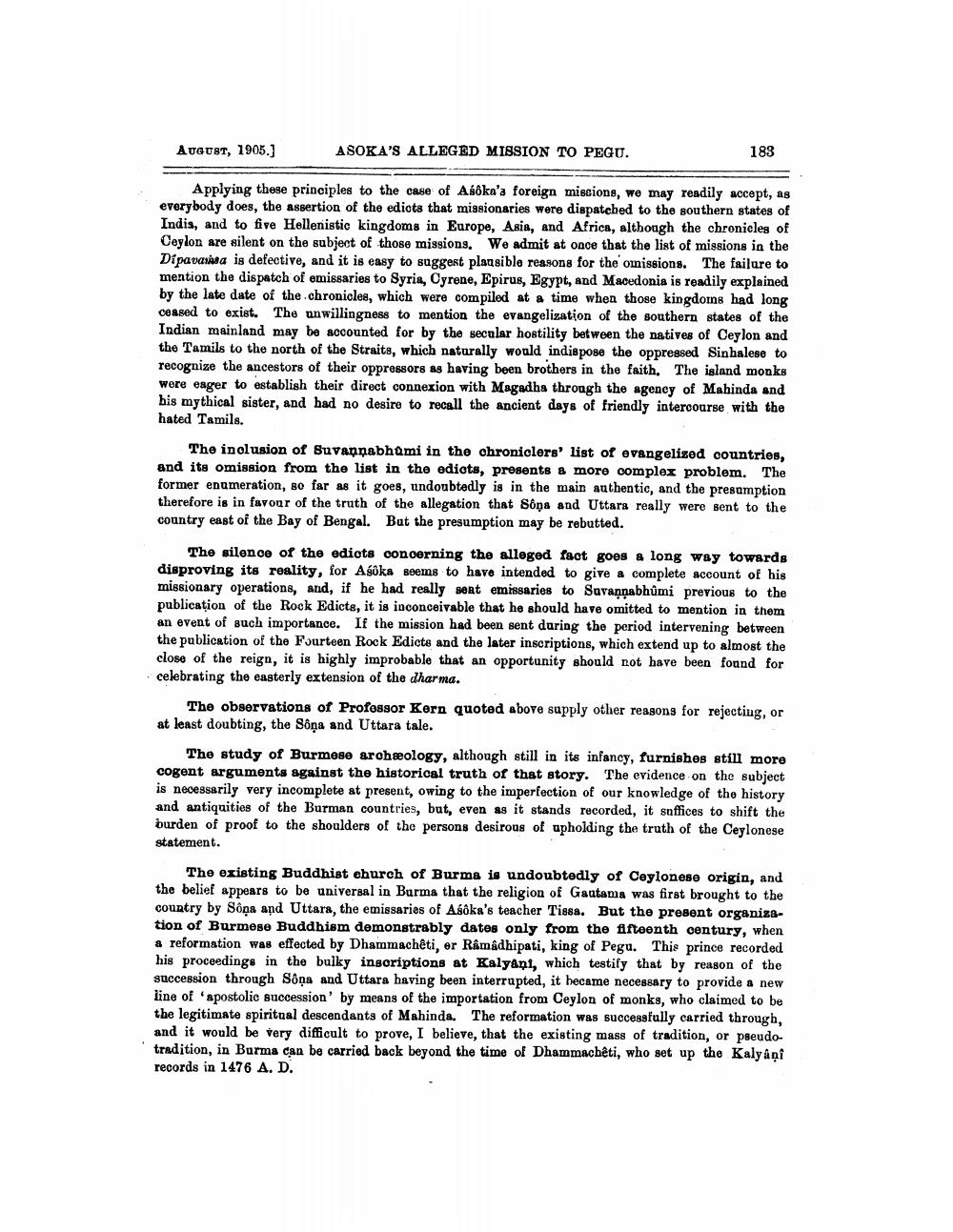________________
AUGUST, 1903.)
ASOKA'S ALLEGED MISSION TO PEGU.
183
Applying these principles to the case of Asoka'a foreign missions, we may readily accept, as everybody does, the assertion of the edicts that missionaries were dispatched to the southern states of Indis, and to five Hellenistic kingdoms in Europe, Asia, and Africa, although the chronicles of Ceylon are silent on the subject of those missions. We admit at once that the list of missions in the Dipavasha is defective, and it is easy to suggest plausible reasons for the omissions. The failure to mention the dispatch of emissaries to Syria, Cyrene, Epirus, Egypt, and Macedonia is readily explained by the late date of the chronicles, which were compiled at a time when those kingdoms had long ceased to exist. The unwillingness to mention the evangelization of the southern states of the Indian mainland may be accounted for by the secular hostility between the natives of Ceylon and the Tamils to the north of the Straits, which naturally would indispose the oppressed Sinhalese to recognize the ancestors of their oppressors as having been brothers in the faith. The island monks were eager to establish their direct connexion with Magadhs through the agency of Mabinda and his mythical sister, and had no desire to recall the ancient days of friendly intercourse with the hated Tamils.
The inclusion of Suvannabhumi in the chroniclers' list of evangelized countries, and its omission from the list in the edicts, presents & more complex problem. The former enumeration, so far as it goes, undoubtedly is in the main authentic, and the presumption therefore is in favour of the truth of the allegation that Sôņa and Uttara really were sent to the country east of the Bay of Bengal. But the presumption may be rebutted.
The silence of the edicts concerning the alleged fact goes a long way towards disproving its reality, for Agôka seems to have intended to give a complete account of his missionary operations, and, if he had really sent emissaries to Savannabhůmi previous to the publication of the Rock Edicte, it is inconceivable that he should have omitted to mention in them an event of such importance. If the mission had been sent during the period intervening between the publication of the Fourteen Rock Edicts and the later inscriptions, which extend up to almost the close of the reign, it is highly improbable that an opportunity should not have been found for celebrating the easterly extension of the dharma.
The observations of Profossor Kern quoted above supply other reasons for rejecting, or at least doubting, the Sôņa and Uttara tale.
The study of Burmese arohæology, although still in its infancy, furnishes still more cogent arguments against the historical truth of that story. The evidence on the subject is necessarily very incomplete at present, owing to the imperfection of our knowledge of the history and antiquities of the Burman countries, but, even as it stands recorded, it suffices to shift the burden of proof to the shoulders of the persons desirous of upholding the truth of the Ceylonese statement.
The existing Buddhist church of Burma is undoubtedly of Ceylonese origin, and the belief appears to be universal in Barma that the religion of Gautama was first brought to the country by Sông and Uttara, the emissaries of Asoka's teacher Tissa. But the present organization of Burmese Buddhism demonstrably dates only from the fifteenth century, when a reformation was effected by Dhammachêti, er Ramadhipati, king of Pegu. This prince recorded his proceedings in the bulky inscriptions at Kalyani, which testify that by reason of the succession through Sôņa and Uttara having been interrupted, it became necessary to provide a new line of 'apostolic succession' by means of the importation from Ceylon of monks, who claimed to be the legitimate spiritual descendants of Mahinda. The reformation was successfully carried through, and it would be very difficult to prove, I believe, that the existing mass of tradition, or pseudotradition, in Burma can be carried back beyond the time of Dhammachêti, who set up the Kalyaņi records in 1476 A. D.




